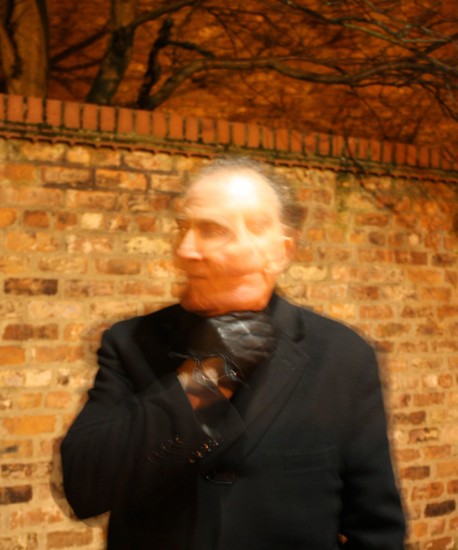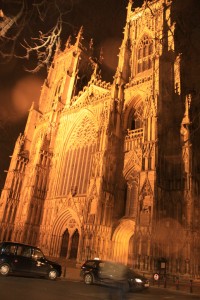They say The Shambles — a picturesque street in Britain’s most haunted city — once ran with blood. These days, the blood is long gone but the ghosts are still here.
 It is a dark and stormy night. No, really! More like an inky March night in northern England with a chilling wind driving a heavy mist into my clothes. It’s impossible to keep warm. Mark Graham, the creator of “Original Ghost Walk Tour of York” and its principal storyteller since 1973, leads us along a famous and creepy street called The Shambles through to the Black Swan Pub. Though famous for the wandering ghost in the bowler hat, the beautiful young female ghost in the long white dress who stares into the fireplace and the disembodied pair of legs that walk about the landlord’s quarters, it’s a barmaid who is the subject of Mark’s tale here tonight.
It is a dark and stormy night. No, really! More like an inky March night in northern England with a chilling wind driving a heavy mist into my clothes. It’s impossible to keep warm. Mark Graham, the creator of “Original Ghost Walk Tour of York” and its principal storyteller since 1973, leads us along a famous and creepy street called The Shambles through to the Black Swan Pub. Though famous for the wandering ghost in the bowler hat, the beautiful young female ghost in the long white dress who stares into the fireplace and the disembodied pair of legs that walk about the landlord’s quarters, it’s a barmaid who is the subject of Mark’s tale here tonight.
With a wave of a gloved hand out of his sombre wool coat, Mark presents to us the Black Swan. “June worked in this pub,” he begins. “One night with nobody else about, she went round back of the bar to tidy up when suddenly she felt a presence. She lost her breath as if someone had taken the air from the room.”
Mark clutches his throat with gloved hands. “Someone or something grabbed her by the throat. It tightened its grip. She kicked back, but no one was there. Just as she felt she would surely succumb, she heard the door slam. She fell to the floor and crumpled into a heap. A man and woman came through the door. The crash had broken the spell. The couple looked down and said to June, ‘We’ll have a pint of bitter and a gin and tonic.’”
In a city that dates from 71 AD when the Roman Ninth Legion built a fortress and armed it with 6000 soldiers, there’s enough history to generate literally legions of ghosts. Voted in the Google Street View Awards as Britain’s Most Picturesque Street, The Shambles itself once ran with blood. The Shambles and off it five narrow snickleways or alleys like The Little Shambles served as an open abattoir and meat market for 600 years.
The overhanging timber-frame buildings seem as if they have twisted themselves to tumble down upon you. Butchers built them in this way to keep the sun off their wares. The street gets its name from the broad shelves upon which butchers displayed their meats in front of their shops. The street was once known by its full name “The Great Flesh Shambles” likely from the Anglo-Saxon term “fleshammels” literally meaning “flesh shelves.”
 It’s here in England’s most haunted city, where butchers once slaughtered and dressed animals for market, tossing guts and blood into the runnel down the middle of the street, that Mark Graham plies his trade of scaring the bejeezus out of visitors… at least those daring enough to sign up for his ghost walk, one of five now operating in the spooky city of about 200,000 souls.
It’s here in England’s most haunted city, where butchers once slaughtered and dressed animals for market, tossing guts and blood into the runnel down the middle of the street, that Mark Graham plies his trade of scaring the bejeezus out of visitors… at least those daring enough to sign up for his ghost walk, one of five now operating in the spooky city of about 200,000 souls.
Murders, suicides, accidents and deadly riots — York has them all. In 1190, the small Jewish community hid from a murderous mob in Clifford’s Tower, a stone keep built on a low hill. After several days and a terrible fire, many took their own lives rather than face a horrific death.
Those who surrendered were killed, in spite of promises otherwise. In this, one England’s most notorious examples of anti-Semitism, 150 to 500 Jews died. Only about 200 Jews live in York today. Even a Roman emperor died in York. When Constantius 1 passed away on a visit in 306 AD, the troops stationed there proclaimed his son the new emperor Constantine the Great.
 Mark Graham huddles us in a corner out of the wind at the side of York Minster Cathedral, the second largest Gothic Cathedral in northern Europe, beneath which the ruins of that Roman fortress still lie. It seems in 1953 a plumber’s apprentice named Harry Martindale was working alone in the cellar of the adjacent Treasurer’s House. He’d just placed his ladder on the remains of an ancient Roman road to drill a hole in the ceiling when he heard a noise. He looked down to see a man in a plumed helmet coming through the wall.
Mark Graham huddles us in a corner out of the wind at the side of York Minster Cathedral, the second largest Gothic Cathedral in northern Europe, beneath which the ruins of that Roman fortress still lie. It seems in 1953 a plumber’s apprentice named Harry Martindale was working alone in the cellar of the adjacent Treasurer’s House. He’d just placed his ladder on the remains of an ancient Roman road to drill a hole in the ceiling when he heard a noise. He looked down to see a man in a plumed helmet coming through the wall.
A soldier on a horse followed and behind that about 20 foot soldiers marched in pairs out one cellar wall and into another, every one of them on their knees. Not on their knees as if in prayer or subservience, on their knees as if they had no legs below them. As each reached the excavation of the Roman road, their full legs appeared beneath them. Harry scrambled out of the cellar and never returned. His doctor ordered him two weeks rest to recover from shock.
With stories and history like this, it’s no wonder York was voted ahead of 130 others as European Tourism City of the Year by European Cities Marketing in June 2007. York beat out second place Gothenburg Sweden and third place Valencia Spain. Of course the five-kilometre Medieval wall that rings old York, the National Railway Museum, river cruises and several grand theatres add to York’s appeal to visitors. It’s also a great jumping off point for visits to the moors and to coastal towns like Whitby, famous for its beach, explorer James Cook’s childhood home and the finest beer battered fish and chips with mushy peas anywhere.
Mark Graham leads us back through The Shambles, stopping before this building and at that corner to spin another spooky ghost story until at last we find ourselves before the 500-year-old Golden Fleece pub a total of five ghosts haunt just four bedrooms in this, one of the most haunted of all buildings in York. We hurry inside out of the gloomy cold, huddle next to the fireplace and over pints of bitter make arrangements to hire a cab back to the hotel rather than face a walk back past Mark Graham’s haunts.
If You Go…
The Original Ghost Walk of York
Photo Credits
All photos © Darcy Rhyno
“Mark Graham offers a guided tour of the haunted hotspots in York.”
“York Minster Cathedral at night, the site of York’s most famous ghost story.”
“Shambles Butcher, one of only two remaining butcher shops on a street that once ran with blood.”


My husband and I visited York many times while living and working there in2004 and 2005. There is so much to see in York and the Ghost Walk was amazing. I have forgotten the guides name, but he made it real and thrilling. Could it have been you Mark? We tried to stay at the front of the group to be sure we did not miss a word. There is a hanging tree also, isn’t there? There is so much history in this city it boggles the mind. It is an experience anyone visiting York should do. I would love to come back and walk the streets again. I miss it all.
I shivered when I heard the story about the Roman soldiers walking across the cellar in the Treasure House. I would love to take this walk. And I would walk back just for the thrill.
Thanks Susan. Glad you felt the prescence. That’s my favourite York ghost story. I especially love the part about the soldiers walking on their knees.